Posterior pelvic tilt - Study guides, Class notes & Summaries
Looking for the best study guides, study notes and summaries about Posterior pelvic tilt? On this page you'll find 752 study documents about Posterior pelvic tilt.
All 752 results
Sort by
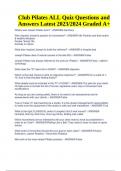 Popular
Popular
-
Club Pilates Exam Questions and Answers Latest 2023/2024 (Graded A+)
- Exam (elaborations) • 16 pages • 2023
- Available in package deal
-
- $14.99
- 2x sold
- + learn more
Club Pilates Exam Questions and Answers Latest 2023/2024 (Graded A+). Who inspired Joseph's passion for movement? - ANSWER-His Parents and their active & healthy lifestyles People "doing" life Animals in nature What item inspired Joseph to build the reformer? - ANSWER-a hospital bed Joseph Pilates died of natural causes in the late 90's - ANSWER-False Joseph Pilates has always referred to his work as "Pilates" - ANSWER-False : called it contrology What does the "O" stand for in SOAP? - A...
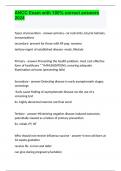 Popular
Popular
-
ANCC Exam with 100% correct answers 2024
- Exam (elaborations) • 131 pages • 2024 Popular
-
Available in package deal
-
- $7.99
- 1x sold
- + learn more
Types of prevention - answer-primary- car restraints, bicycle helmets, immunizations secondary- prevent for those with RF-pap, mammo tertiary-mgmt of established disease- meds, lifestyle Primary - answer-Preventing the health problem, most cost effective form of healthcare **IMMUNIZATIONS, ensuring adequate illumination at home (preventing falls) Secondary - answer-Detecting disease in early asymptomatic stages, screenings -Early cause finding of asymptomatic disease via the use of a sc...
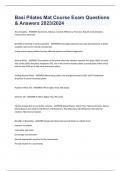
-
Basi Pilates Mat Course Exam Questions & Answers 2023/2024
- Exam (elaborations) • 21 pages • 2023
-
Available in package deal
-
- $14.49
- 1x sold
- + learn more
Basi Pilates Mat Course Exam Questions & Answers 2023/2024 Ten principles - ANSWER-Awareness, Balance, Control, Efficiency, Precision, Breath, Concentration, Center, Flow, Harmony Benefits of working in neutral position - ANSWER-Encourages balanced muscular development of pelvic complex, and correct muscle recruitment. Using neutral spine position teaches efficient posture and lateral alignment. Neutral Pelvis - ANSWER-The position of the pelvis when the anterior superior iliac spine (...
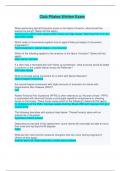
-
2023/2024 Club Pilates Written Exam - Complete Solutions
- Exam (elaborations) • 14 pages • 2024
-
- $16.49
- 1x sold
- + learn more
2023/2024 Club Pilates Written Exam - Complete Solutions When performing Spinal Extension prone on the Spine Corrector, what should the teacher be doing? (Select all that apply) Assisting the clients while keeping their ankles and legs steady, Watching their form and alignment nearby Which order of movements explains how to apply Pilates principles of movement progression? Flexion/extension, lateral rotation, circumduction Which of the following applies to the anatomy of the Spine Corrector? (...
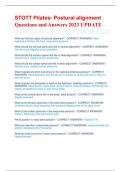
-
STOTT Pilates- Postural alignment Questions and Answers 2023 UPDATE
- Exam (elaborations) • 7 pages • 2023
-
- $13.99
- 1x sold
- + learn more
STOTT Pilates- Postural alignment Questions and Answers 2023 UPDATE What are the four types of postural alignment? - CORRECT ANSWERS- Ideal, kyphosis-lordships, flat-back, sway-back postures What should the cervical spine look like in neutral alignment? - CORRECT ANSWERS- Normal curve, slightly convex anteriorly What should the thoracic spine look like in ideal alignment? - CORRECT ANSWERS- Normal curve, slightly convex posteriorly What should the lumbar spine look like in ideal alig...
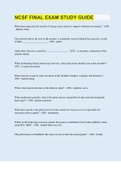
-
NCSF FINAL EXAM STUDY GUIDE | 150 Questions with 100% Correct Answers | Updated & Verified
- Exam (elaborations) • 15 pages • 2023
-
- $15.49
- 1x sold
- + learn more
What term represents the transfer of energy across joints to support voluntary movement? - ANS - Kinetic chain The posterior pelvic tilt seen in this picture, is commonly seen in bilateral leg exercises a result of tight ____________________. - ANS - glutes Ankle dorsi flexion is caused by _________________. - ANS - a concentric contraction of the anterior tibialis When performing biceps and triceps exercises, what joint action should occur at the shoulder? - ANS - no joint movement What...
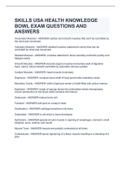
-
SKILLS USA HEALTH KNOWLEDGE BOWL EXAM QUESTIONS AND ANSWERS
- Exam (elaborations) • 21 pages • 2023
-
Available in package deal
-
- $12.99
- 3x sold
- + learn more
Involuntary Muscles - ANSWER-cardiac and smooth muscles that can't be controlled by the mind and movement Voluntary Muscles - ANSWER-skeletal muscles (attached to bone) that can be controlled by mind and movement Skeletal Muscles - ANSWER--muscles attached to bone-voluntary-contracts quickly and fatigues easily Smooth Muscles - ANSWER-visceral (organ) muscles-involuntary-wall of digestive track, uterus, blood vessels-controlled by automatic nervous system Cardiac Muscles - ANSWER--h...
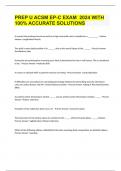
-
PREP U ACSM EP-C EXAM 2024 WITH 100% ACCURATE SOLUTIONS
- Exam (elaborations) • 40 pages • 2024
-
- $15.49
- + learn more
A muscle that produces low force and has a high contractile rate is classified as a _________ - Precise Answer Longitudinal Muscle The ankle's most stable position is in ______ due to the overall shape of the ______ - Precise Answer Dorsiflexion; talus During the pre-participation screening your client is determined to have 4 risk factors. This is considered to be: - Precise Answer Moderate Risk A reason or rationale NOT to perform exercise or testing - Precise Answer Contraindicat...
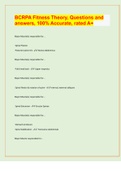
-
BCRPA Fitness Theory, Questions and answers, 100% Accurate, rated A+
- Exam (elaborations) • 5 pages • 2023
-
Available in package deal
-
- $8.49
- 1x sold
- + learn more
BCRPA Fitness Theory, Questions and answers, 100% Accurate, rated A+ Major Muscle(s) responsible for... Spinal Flexion Posterior pelvic tilt - -Rectus Abdominus Major Muscle(s) responsible for... Pulls head back - -Upper trapezius Major Muscle(s) responsible for... Spinal flexion & rotation of spine - -Internal, external obliques Major Muscle(s) responsible for... Spinal Extension - -Erector Spinae Major Muscle(s) responsible for... Stomach enclosure Spin...
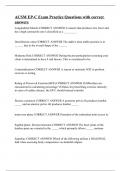
-
ACSM EP-C Exam Practice Questions with correct answers
- Exam (elaborations) • 51 pages • 2024
- Available in package deal
-
- $15.49
- + learn more
Longitudinal Muscle CORRECT ANSWER A muscle that produces low force and has a high contractile rate is classified as a _________ Dorsiflexion; talus CORRECT ANSWER The ankle's most stable position is in ______ due to the overall shape of the ______ Moderate Risk CORRECT ANSWER During the pre-participation screening your client is determined to have 4 risk factors. This is considered to be: Contraindication CORRECT ANSWER A reason or rationale NOT to perform exercise or testing Ratin...
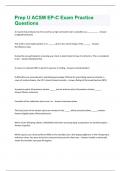
-
Prep U ACSM EP-C Exam Practice Questions And Answers Graded A+
- Exam (elaborations) • 40 pages • 2024
- Available in package deal
-
- $9.69
- + learn more
A muscle that produces low force and has a high contractile rate is classified as a _________ - AnswerLongitudinal Muscle The ankle's most stable position is in ______ due to the overall shape of the ______ - AnswerDorsiflexion; talus During the pre-participation screening your client is determined to have 4 risk factors. This is considered to be: - Answer-Moderate Risk A reason or rationale NOT to perform exercise or testing - Answer-Contraindication If difficulties are encountered in cal...

How much did you already spend on Stuvia? Imagine there are plenty more of you out there paying for study notes, but this time YOU are the seller. Ka-ching! Discover all about earning on Stuvia


